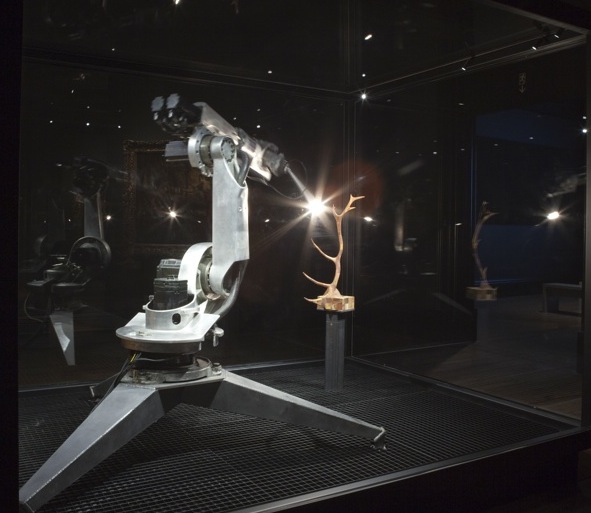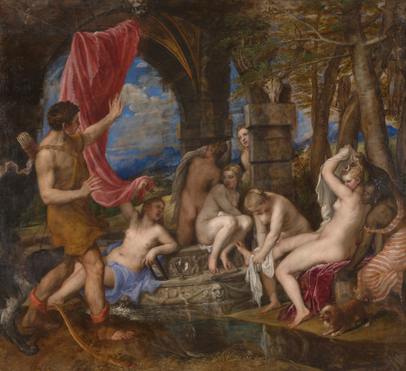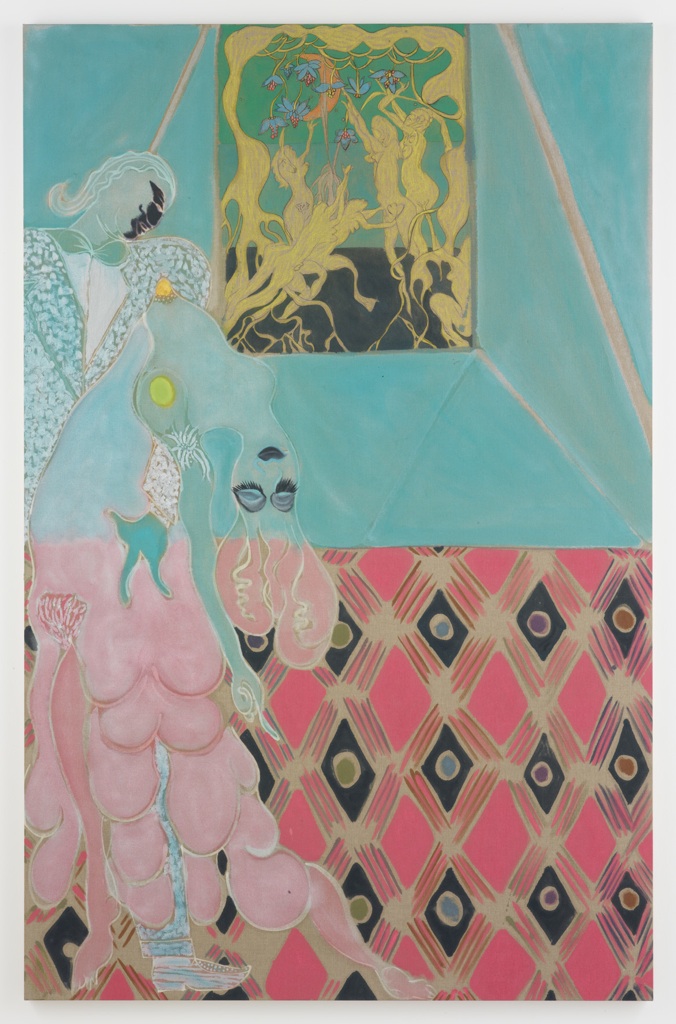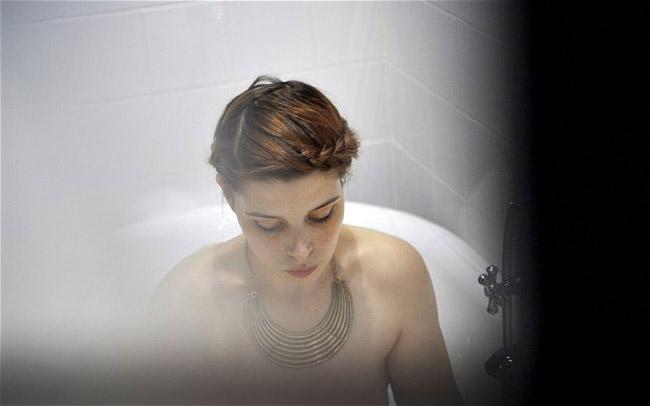Three paintings by Titian depicting stories from Ovid’s poem Metamorphoses welcome you to the National Gallery’s exhibition Metamorphosis: Titian 2012. Diana and Callisto shows Diana casting out the pregnant nymph Callisto from her company. Diana and Actaeon depicts the young Actaeon out hunting and stumbling into a sacred grotto where Diana and her nymphs are bathing; and in The Death of Actaeon, we see the goddess exacting vengeance on the intruder by turning him into a stag to be torn to pieces by his own hounds.
You may remember the public appeals that helped save these splendid paintings for the nation and this is the first time they have been shown together since they left Titian's studio; but the exhibition is not about the paintings per se. They were the catalyst for an ambitious project involving the National Gallery and the Royal Opera House and the production of three new ballets inspired by the paintings. The costumes and sets were designed by contemporary artists – Mark Wallinger, Conrad Shawcross and Chris Ofili – who show their designs alongside other work produced in response to Titian’s masterpieces.
 An exhibition as diverse as this is difficult to stage, but the gallery has made a valiant stab at a difficult job. Titian is a hard act to follow and walking from the room where his pictures hang into a gallery lined with Ofili’s canvases requires a gear change that few will manage with ease.
An exhibition as diverse as this is difficult to stage, but the gallery has made a valiant stab at a difficult job. Titian is a hard act to follow and walking from the room where his pictures hang into a gallery lined with Ofili’s canvases requires a gear change that few will manage with ease.
Negotiating the shift from the 16th century to the present day is easier with Shawcross’s Trophy (pictured above right). His Diana is an industrial robot reprogrammed to move in an unexpectedly sensual way. At the end of her mechanical arm is a proboscis with which she preens herself like a cat. She notices Actaeon and his presence sparks an exploration of her nether regions, as though she were discovering her sexuality for the first time. He takes the form of an antler, fashioned in wood by the robot to mimic the silhouette of Titian’s Actaeon. Turning its attention to the intruder, the machine performs a threatening yet balletic series of manoeuvres. The artist’s set for the ballet Machina similarly features a robot whose arm has a seven-metre stretch that could do serious damage to the dancers Carlos Acosta and Tamara Rojo, if they were to venture too close.
 Titian’s nymphs are (pictured left: Diana and Actaeon, 1556-9) not, of course, the only female nudes in the National Gallery intended to delight the male gaze. Phillip II of Spain, who commissioned the paintings, even kept them hidden from female eyes. Wallinger invites both sexes to engage in a far more overt form of voyeurism; in place of images, he offers us the real thing. Behind the closed door of his bathroom is a real-life Diana (main picture); if you peer through the eyeholes drilled in the wall, gawp through the chink in the frosted glass, squint through the slatted blind or put your eye to the keyhole like a peeping Tom, you are rewarded with titillating glimpses of a nude woman. The models, all of whom are called Diana, each spend two hours on display – which is where the problem with the idea lies. Voyeurism is only really exciting if it is illicit, and knowing that Wallinger’s bathers are being paid to perform not only spoils the fun but removes the element of guilt, which is another crucial ingredient.
Titian’s nymphs are (pictured left: Diana and Actaeon, 1556-9) not, of course, the only female nudes in the National Gallery intended to delight the male gaze. Phillip II of Spain, who commissioned the paintings, even kept them hidden from female eyes. Wallinger invites both sexes to engage in a far more overt form of voyeurism; in place of images, he offers us the real thing. Behind the closed door of his bathroom is a real-life Diana (main picture); if you peer through the eyeholes drilled in the wall, gawp through the chink in the frosted glass, squint through the slatted blind or put your eye to the keyhole like a peeping Tom, you are rewarded with titillating glimpses of a nude woman. The models, all of whom are called Diana, each spend two hours on display – which is where the problem with the idea lies. Voyeurism is only really exciting if it is illicit, and knowing that Wallinger’s bathers are being paid to perform not only spoils the fun but removes the element of guilt, which is another crucial ingredient.
Diana’s emblem is a crescent moon and Titian’s goddess wears a crescent-shaped diadem. Through an association of ideas, Wallinger likens the Apollo moon landing to Actaeon’s trespass; when, on arrival, the astronauts played golf and baseball, he felt it was a violation of the virgin terrain. His set for Trespass features a giant semi-circular mirror the shape of an astronaut’s visor and a backdrop resembling samples of lunar rock – actually made by scanning crumpled foil into his computer.
 Finding Titian’s paintings too daunting, Ofili went to the source for inspiration. In Ovid’s epic poem, he discovered a magical realm full of passion and desire, which he conjures with psychedelic rivers of vivid colour (Ovid-Bather, Ovid-Stag) or veils of smoky darkness (Ovid-Windfall), and peoples with mythic beings such as nymphs and goddesses, stags and soothsayers.
Finding Titian’s paintings too daunting, Ofili went to the source for inspiration. In Ovid’s epic poem, he discovered a magical realm full of passion and desire, which he conjures with psychedelic rivers of vivid colour (Ovid-Bather, Ovid-Stag) or veils of smoky darkness (Ovid-Windfall), and peoples with mythic beings such as nymphs and goddesses, stags and soothsayers.
The echoes are not of Titian so much as Gauguin, Picasso and Matisse, and of Japanese prints and Aubrey Beardsley’s erotica. Ofili stirs these borrowings into a potent brew that has a unique magic all its own. Because they reveal their secrets slowly, it's worth spending some time with these pictures; only then do you sense the artist exploring new ideas and developing new ways of working. The most recent paintings, Ovid-Destiny and Ovid-Desire, are far more down to earth. In place of mystic dreamscapes, we are indoors. Ovid-Desire (pictured above right) shows a couple dancing; he wears a spangled suit, she is half naked in a dress layered with flesh pink flounces dusted with a sheen of silver. The floor, a vertical plane patterned with emphatic diamonds, leads up to a turquoise wall and a window looking onto an Edenic landscape where naked women (Diana and her nymphs, perhaps) cavort beneath a crescent moon. While indoors the atmosphere is hot and sultry with desire, the pleasures pursued outdoors seem completely innocent.
Not only are these Ofili’s most complex and interesting paintings to date, but I get the impression that he is on a roll. This could be just the beginning.
- Metamorphosis: Titian 2012 at the National Gallery until 23 September. Admission free
- Trespass, Diana and Actaeon and Machina at the Royal Opera House 14-20 July. On 16 July, the performance will be screened live in Trafalgar Square










![SEX MONEY RACE RELIGION [2016] by Gilbert and George. Installation shot of Gilbert & George 21ST CENTURY PICTURES Hayward Gallery](/sites/default/files/styles/thumbnail_125_x_125_/public/mastimages/Gilbert%20%26%20George_%2021ST%20CENTURY%20PICTURES.%20SEX%20MONEY%20RACE%20RELIGION%20%5B2016%5D.%20Photo_%20Mark%20Blower.%20Courtesy%20of%20the%20Gilbert%20%26%20George%20and%20the%20Hayward%20Gallery._0.jpg?itok=3oW-Y84i)




Add comment